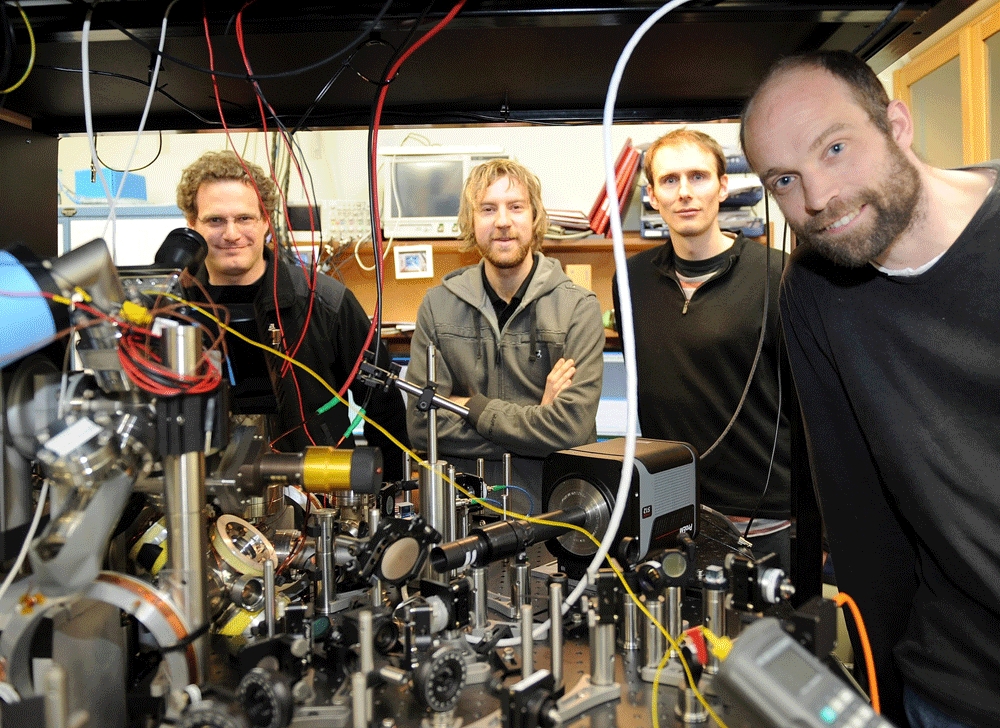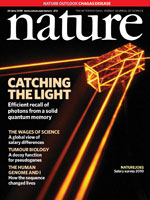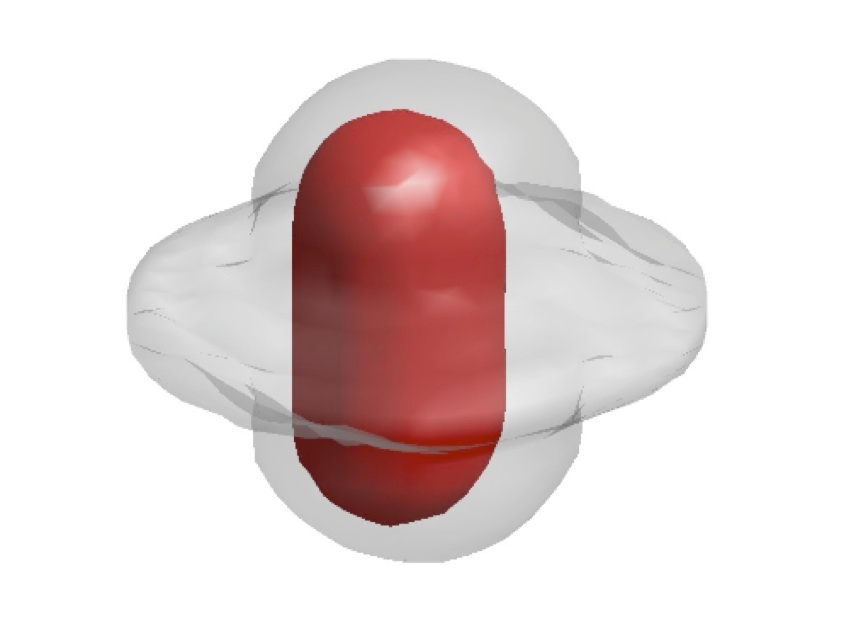|
Vortex states in Onsager-Kraichnan condensation
Despite the prominence of Onsager’s point-vortex model as a statistical description of 2D classical turbulence, a first-principles development of the model for a realistic superfluid has remained an open problem. Here we develop a mapping of a system of quantum vortices described by the homogeneous 2D Gross-Pitaevskii equation (GPE) to the point-vortex model, enabling Monte Carlo sampling of the vortex microcanonical ensemble. We use this approach to survey the full range of vortex states in a 2D superfluid, from the vortex-dipole gas at positive temperature to negative-temperature states exhibiting both macroscopic vortex clustering and kinetic energy condensation, which we term an Onsager-Kraichnan condensate (OKC). Damped GPE simulations reveal that such OKC states can emerge dynamically, via aggregation of small-scale clusters into giant OKC clusters, as the end states of decaying 2D quantum turbulence in a compressible, finite-temperature superfluid. These statistical equilibrium states should be accessible in atomic Bose-Einstein condensate experiments.
Read more
|
|

Emergence of an Onsager-Kraichnan condensate with increasing point-vortex energy. Blue and green points indicate vortices that are clustered (links indicate the cluster), and green points show vortices that are paired with an anti-vortex to form a vortex dipole.
|
|
|
Fingerprinting Roton Excitation
This high profile paper published in Physical Review Letters by Russell Bisset and Blair Blakie describes a novel scheme for fingerprinting the elusive roton excitation in a dipolar Bose- Einstein condensate. This excitation was first predicted more than 10 years ago but has yet to be seen experimentally. A major issue has been a technique for detecting this excitation. In this work we show that density fluctuation measurements provide a tool ideally suited to this purpose.
After completing this work as part of his PhD, Russell Bisset has gone to Los Alamos National Laboratory (New Mexico) to undertake a postdoctoral fellowship.
|
|

Figure shows the schematic cell geometries we suggest for measuring number fluctuations to show that the flattened condensate system has a roton.
|
|
|
Turbulent times for quantum vortices
One has only to watch the chaotic eddies in a rapidly flowing stream to realize that fluid turbulence is ubiquitous in nature, yet many of the underlying mechanisms remain mysterious. This is strikingly demonstrated by the emergence of large-scale rotating structures from the turbulent maelstrom in a two-dimensional turbulent flow, as first observed by Galileo on the surface of Jupiter (the Great Red Spot). These organized structures are long-lived, suggesting thermal equilibrium, yet they are driven by the highly chaotic turbulent fluid dynamics operating at smaller scales.
In quantum fluids, such as superfluid helium at low temperature, rotation occurs only in discrete units called quantized vortices, resulting in strong constraints on the allowed fluid behavior. This means that a much clearer understanding of turbulence may be achievable in quantum fluids, particularly if the dynamics of vortices are further limited by reducing the dimensionality. In our paper, we report a theoretical and computational study demonstrating of an inverse cascade of energy to large scales, where quantum vortices of the same rotating form giant coherent clusters as a result of superfluid turbulence. This work opens a new perspective on the kinds of turbulent dynamics that can occur in superfluids, and may lead to now insights into the fundamental nature of the turbulence phenomenon.
Full article here
|
|

Inverse energy cascade in 2D quantum turbulence: a superfluid flowing in from the left is stirred by a grid of obstacles, generating large scale clustering downstream from the grid. Dots show positive (red) and negative (blue) quantum vortices that are either free, or part of a cluster; vortices comprising bound vortex anti-vortex pairs are shown in green. The stream lines show the velocity field due to the total vortex configuration.
|
|
| |
|
|
|
|
Computer Model Promising for Medical Screening and Security Systems
University of Otago physicist Igor Meglinski and Vladislav Yakovlev of Texas A&M University led an international team of researchers developing a computer model for assessing tissue transmission spectra. This model could potentially identify the best conditions for optical diagnostics, laser surgery and the deployment of facial recognition security systems.
Read more here
Full article here |
|

|
|
| |
|
|
|
|
Otago scientists make quantum leap in capturing atom
University of Otago Physicists are the first in the world to consistently isolate and capture a single atom - and the first to take its photograph. Their discovery has defied accepted science and might help turn the building blocks of life into ultrafast quantum-logic computers, which are still being developed. Mikkel Andersen, Tzahi Grunzweig, Andrew Hilliard and Matt McGovern started work on the project three years ago. Nature
|
|

|
|
| |
|
|
|
|
Otago Researcher in major Physics Breakthrough:
The quantum computers and communication networks of the future will require devices that can efficiently store and retrieve the quantum nature of light. Jevon Longdell and colleagues from the Australian National University have recently demonstrated an efficient solid-state quantum memory with light stored by praseodymium ions within a single yttrium orthosilicate crystal. The nature cover depicts a laser beam exciting the crystal used for the quantum memory demonstration. Nature
|
|
 |
|
| |
|
|
|
|
Dynamic Dance of a Vortex-Antivortex Pair
Superfluid turbulent flows, comprised of quantum vortices, offer a new setting in which to study turbulence phenomena. Recent work by Ashton Bradley and colleagues studying the breakdown of superfluidity revel vortex-antivortex pairs formed in the wake of an obstacle moving through a Bose-Einstein condensate (BEC). A delecate dance ensues, and the quantum whirlpools eventually annihilate each other, emitting a burst of sound. The process has been observed and studied theoretically in detail for the first time, shedding new light on the curious physics of superfluidity.
See more
|
|

|
|
| |
|
|
|
|
Ghosts in a superfluid:
Spontaneous quantum whilpools in ultracold matter
Discovering exactly how the Big Bang created the universe may be a step closer – thanks to the combined efforts of physicists from opposite sides of the world.
Experimental physicists from the University of Arizona worked with theoretical physicists from the University of Queensland Dr Ashton Bradley (now a Research Fellow at the University of Otago) and Dr Matthew Davis to determine how Bose-Einstein condensates (BECs) form. Their findings are a world first and appear in this week’s issue of the prestigious scientific journal, Nature. Media Article
|
|
|
|
| |
|
|
|
|
Dipolar Gases:
In dilute gaseous samples of dipolar atoms (or polar molecules) the particles interact at a distance and with directional dependence, just like two bar-magnets. Our work in this area has initially focused upon bringing our finite temperature theory to this system (article). In work underway we are examining the diverse and fascinating new properties of these systems, such are constructing their phase diagram and exploring how the interactions cause the system to collapse. [This work is supported by the Marsden Fund of New Zealand]
Spinor Gases:
In a spinor gas the magnetic moments of the constituent atoms can be in one of several available magnetic orientations. In collaboration with Ashton Bradley (Otago) and Yuki Kawaguchi (University of Tokyo) we are developing new theoretical techniques for understanding the interplay between the many-particle dynamics, thermal fluctuations and the emergence of magnetic order. [This work is supported by a FRST IIOF Grant]
|
|
 
|
|
| |
|
|
|
|
Demonstration of strong coupling between an atom and a monolithic microresonator
Strong coupling has been demonstrated between a single atom and a single photon in a monolithic optical microresonator, for the first time. This work done in collaboration with researchers at the California Institute of Technology and the University of Auckland appears in Nature. The system is silicon chip based and can be fibre coupled with extremely high efficiency, and should provide an enabling step for complex experiments in the fields of cavity quantum electrodynamics and quantum information science.
|
|

Demonstration of strong coupling between an atom and a monolithic microresonator
|
|
 |
|
Continuous variable purification of non-classical states
Dr. Warwick Bowen, along with colleagues at Universitat Erlangen-Nurnberg in Germany, has performed the first demonstration of non-classical state purification in the continuous variable regime. These results have been recently published in Physical Review Letters.
|
|
 Continuous variable purification of non-classical states
|
|
 |
|
Thermal Vortex-Pair Creation in 2D Bose-Einstein Condensates
Drs Tapio Simula and Blair Blakie have used classical field techniques to explore the superfluid phase diagram of a trapped 2D Bose gas. These theoretical results are in good agreement with recent experiments by the ENS group of Jean Dalibard. This work appears in Physical Review Letters and additional results and movies from this work are available here.
|
|
 The influence of thermally activated vortices on an interference experiment
|
|
 |
|
Proposal for multi-wavelength entanglement
The proposal of a new technique to generate multi-wavelength entanglement by Dr. Warwick Bowen in collaboration with the group of Dr. Ping Koy Lam at the Australian National University has been featured on the cover of Physical Review Letters.
|
|
 Proposal for producing multi-wavelength entanglement
|
|
 |
|
Critical temperature of a trapped Bose gas: comparison of theory and experiment
Dr Matthew Davis of the University of Queensland and Dr Blair Blakie of the Otago UCA group report the results of a detailed theoretical study of the shift in critical temperature of a harmonically confined Bose gas. The results of this study find excellent agreement with the experimental results of Gerbier et al. [Phys. Rev. Lett. 92, 030405 (2004)] and quantifies the likelihood of observing critical fluctuations in experiments. This work represents the first quantitative comparison of a classical field method with experiment and appears in Physical Review Letters
|
|
 Comparison of theoretical and experimental results for the shift in critical temperature of condensation.
|
|
 |
|
Transition from BEC to Berezinskii-Kosterlitz-Thouless phase
Work done by Drs Tapio Simula and David Hutchinson, in collaboration with Dr Mark Lee from Oxford University, has quantified the phase diagram for a 2D trapped Bose gas (to appear in Philosophical Magazine Letters). A preprint of this work is available here.
|
|
 Oppositely charged vortices in a 2D BEC
|
|
 |
|
Fermion cooling with Optical Lattices
UCA theorists Dr Blair Blakie and Ms Alice Bezzet have studied the loading of finite temperature Fermions into an optical lattice, and have shown that under appropriate conditions the temperature of the system reduces exponentially with lattice depth. The results of this study are published in Physical Review A.
|
|
 Fermions in a 3D optical lattice
|
|
 |
|
Sound Propagation in Rotating BECs
Work done by UCA theorists in collaboration with the experimental group of Nobel Prize winner Prof. Eric Cornell has examined sound propagation in rapidly rotating BECs. The results of this study are published in Physical Review Letters.
|
|
 Comparison of theory and Experiment
|
|
 |
|
Quantum Turbulence in Colliding BECs
Pioneering application of stochastic techniques to the collision of BECs reveals the phenomenon of quantum turbulence in the dynamics of the scattered atoms, and has been featured on the cover of Physical Review Letters.
|
|
 Turbulence in the collision of BECs.
|
|
 |
|
World's First Ultra-Cold atom Collider
Work by the BEC experimental group on "Imaging of s and d Partial-Wave Interference in Quantum Scattering of Identical Bosonic Atoms" has been featured on the cover of Physical Review Letters. An introductory overview of the Ultra-cold atom collider experiments is given here
|
|
 Image of s and d Partial-Wave Interference
|
|
 |
|
Classical Field Method for Trapped BECs
Dr Blair Blakie in collaboration with Dr Matthew Davis at the University of Queensland have developed a practical formalism for simulating ultra cold Bose gases in harmonic traps using the classical field technique. This work appears in Physical Review A.
|
|

Classical field at for a matter wave at the critical point
|
|
 |
|
UCA Scientist First to Teleport Atoms
Dr Murray Barrett's work with Dave Wineland's NIST group appears in an article published in Nature. In these experiments Dr Barrett provided the first demonstration of atom teleportation.
|
|
 Dr Barrett's work on the cover of Nature magazine
|
|
 |
|
Novel Scheme for Manipulating BECs in Optical Lattices
Work by the BEC experimental group published in Physical Review A, shows how to rapidly transfer a BEC in an optical lattice into a Bloch state near the band edge.
|
|
 Lattice manipulation suddenly transfers the BEC into a single Bloch state
|
|




